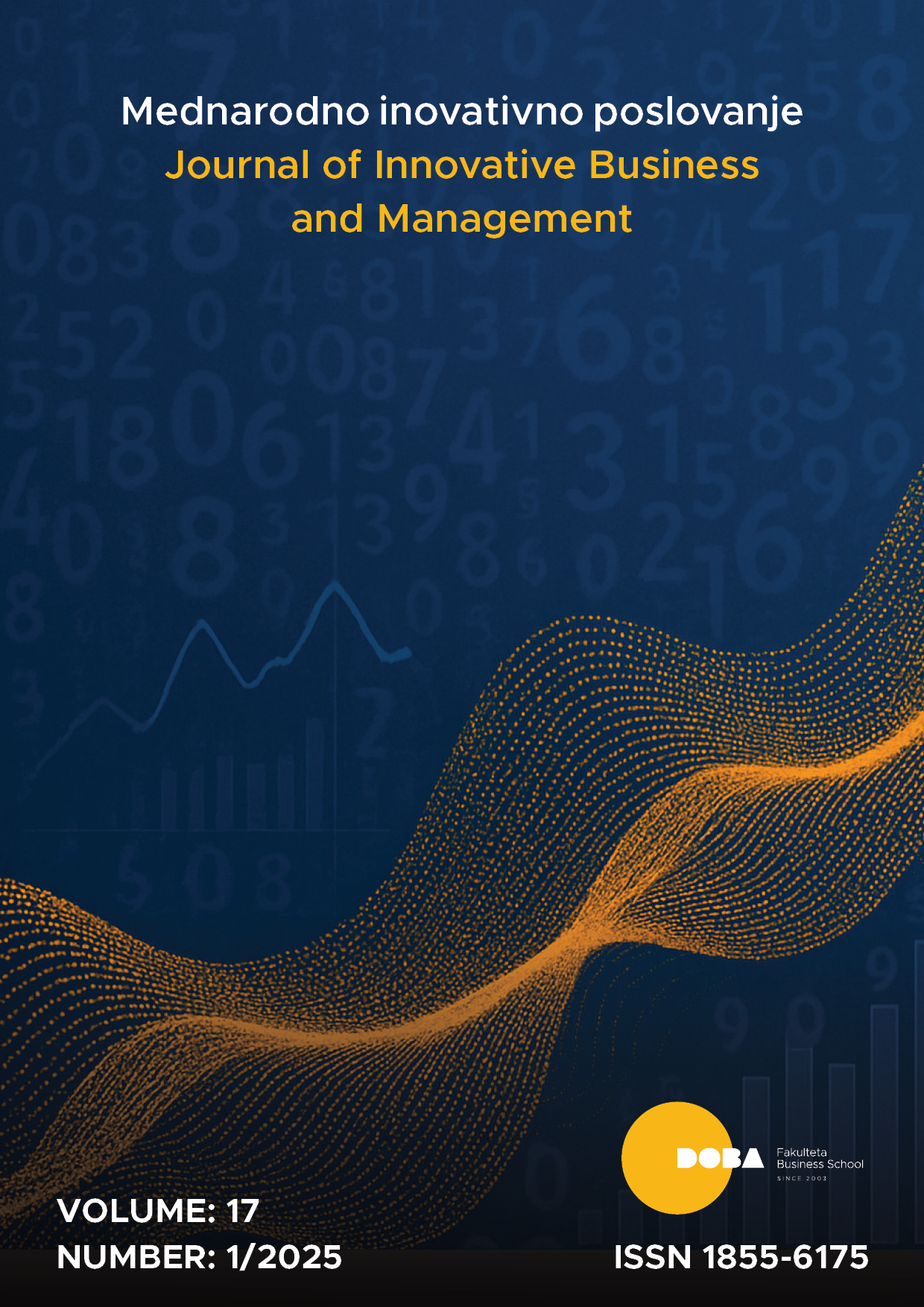Gross capital flows as a superior metric in explaning capital flows and allocation in the EU: evidence from 1995-2018
DOI:
https://doi.org/10.32015/JIBM.2025.17.1.7Keywords:
net capital flow, gross capital flow, Lucas paradox, allocation puzzleAbstract
Research on Lucas’s paradox and the allocation puzzle has not reached a consensus on which type of capital should be used to study the magnitude and direction of capital flows. With limited exceptions, the analysis of Lucas’s paradox and the allocation puzzle has predominantly relied on net capital flow variables, as opposed to gross capital inflows and outflows. The frequent inconsistencies in the conclusions of numerous studies may be attributed to variations in variable selection and the lack of precise definition of the chosen variables within the models.
The primary objective of this study is to ascertain the appropriate capital flow measure for empirical research of these phenomena. The study was conducted on EU member states and it examined the stability and procyclicality of gross inflows and outflows, as well as net capital flows.
The findings strongly suggest that gross capital flow categories should be employed in such analyses, and the conventional reliance on net capital flow variables should be abandoned.
References
https://www.tandfonline.com/doi/full/10.1080/00036846.2017.1321840?scroll=top&needAccess=true
Albuquerque, R., Bauer, G. H., & Schneider, M. (2004). International equity flows and returns: a quantitative equilibrium approach. European Central Bank Working Paper Series No. 310, 1-71.
https://papers.ssrn.com/sol3/papers.cfm?abstract_id=472424
Alfaro, L., Kalemli-Ozcan, S., & Volosovych, V. (2008). Why doesn't capital flow from rich to poor countries? An empirical investigation. The Review of Economics and Statistics, 90(2), 347-368.
https://direct.mit.edu/rest/article-abstract/90/2/347/57727/Why-Doesn-t-Capital-Flow-from-Rich-to-Poor?redirectedFrom=fulltext
Borio, C., & Disyatat, P. (2016). Capital flows and the current account: Taking financing (more) seriously. Puey Ungphakorn Institute for Economic Research, Discussion Paper No. 14.
https://ideas.repec.org/p/pui/dpaper/14.html
Broner, F., Didier, T., Erce, A., & Schmukler, S. L. (2013). Gross capital flows: Dynamics and crises. Journal of monetary economics, 60, 113-133.
https://www.sciencedirect.com/science/article/abs/pii/S0304393212001675
Busse, M., & Hefeker, C. (2007). Political risk, institutions and foreign direct investment. European Journal of Political Economy, Vol. 23(2), 397-415.
https://www.sciencedirect.com/science/article/abs/pii/S0176268006000267
Calderon, C., & Kubota, M. (2013). Sudden stops: Are global and local investors alike? Journal of International Economics, No. 89, 122-142.
https://www.sciencedirect.com/science/article/abs/pii/S0022199612001006
Caraveli, H. (2016). Global imbalances and EU core-periphery division. World Review of Political Economy Vol.7, No. 1, 29-55.
https://www.jstor.org/stable/10.13169/worlrevipoliecon.7.1.0029?seq=1
Forbes, K., & Warnock, F. E. (2012). Capital flow waves: Surges, stops, flight, and retrenchment. Journal of International Economics 88, 235-251.
https://www.sciencedirect.com/science/article/abs/pii/S0022199612000566
Herrmann, S., & Kleinert, J. (2014). Lucas paradox and allocation puzzle - is the euro area different? Discussion paper Deutsche Bundesbank No 06/2014.
https://papers.ssrn.com/sol3/papers.cfm?abstract_id=2796952
Hobza, A., & Zeugner, S. (2014). The "imbalanced balance" and its unravelling: current accounts and bilateral financial flows in the euro area. European Commission Economic papers, No 520.
https://ec.europa.eu/economy_finance/publications/economic_paper/2014/ecp520_en.htm
IMF (2009) Balance of Payments and International Investment Position Manual BPM6.
https://www.imf.org/external/pubs/ft/bop/2007/bopman6.htm
Jensen, N.M. (2003). Democratic governance and multinational corporations: political regimes and inflows of foreign direct investment. Int Org 57(03), 587-616.
https://www.cambridge.org/core/journals/international-organization/article/abs/democratic-governance-and-multinational-corporations-political-regimes-and-inflows-of-foreign-direct-investment/246025D12F8982BCC871F6398EB57720
Lane, P. R., & Millesi-Ferretti (2001). Long-Term Capital Movements, NBER Macroeconomics Annual, Vol. 16, 73-116.
https://www.nber.org/papers/w8366
Mehigan, C. (2018). Measurement and identification of capital inflow surges. Review of the OECD Code of Liberalisation of Capital Movements 2/REV1, 1-16.
chrome-extension://efaidnbmnnnibpcajpcglclefindmkaj/https://www.oecd.org/investment/investment-policy/Measurement-identification-of-capital-inflow-surges-technical-note.pdf
Millesi-Ferretti, G., & Tille C. (2011). The great retrenchment: international capital flows during the global financial crisis. Economic Policy, April (11), 285-342.
https://academic.oup.com/economicpolicy/article-abstract/26/66/289/2918382?redirectedFrom=fulltext
Obstefld, M. & Taylor, A. M. (2004). Global Capital Markets. New York: Cambridge University Press.
https://books.google.si/books?hl=en&lr=&id=KhXl9OT0WigC&oi=fnd&pg=PR9&dq=Obstfeld,+M.+%26+Taylor,+A.+M.+(2004).+Global+Capital+Markets.+New+York&ots=nXBnNnJ9uO&sig=NJZYQCSQvxUrPWt4JWwYILh9xQ4&redir_esc=y#v=onepage&q&f=false
Obstfeld, M. (2012). Does current account still matter? American Economic Review, American Economic Association, Vol 102(3), 1-23.
https://www.aeaweb.org/articles?id=10.1257/aer.102.3.1
Pagliari, M. S., & Hannan, S. A. (2017). The Volatility of Capital Flows in Emerging Markets: Measures and Determinants. IMF Working Paper WP/17/41, 1-57.
https://www.imf.org/en/Publications/WP/Issues/2017/03/07/The-Volatility-of-Capital-Flows-in-Emerging-Markets-Measures-and-Determinants-44725
Portes, R., & Rey, H. (2005). The determinants of cross-border equity flows. Journal of International Economics 65, 269-296.
https://www.sciencedirect.com/science/article/abs/pii/S0022199604000716
Rey, H. (2013). Dilemma not trilemma: The global financial cycle and monetary policy independence. Federal Reserve Bank of Kansas City Economic Symposium, 285-333.
https://ideas.repec.org/p/nbr/nberwo/21162.html
Shin, S. H. (2012). Global banking glut and loan risk premium. IMF Annual research conference November 10-11, 2011.
https://www.researchgate.net/publication/254073025_Global_Banking_Glut_and_Loan_Risk_Premium
Toš, T, & Kvesić, M. (2017) Problem in analysing the Lucas Paradox: Why we don’t have an answer? Third international scientific conference ERAZ 2017, Belgrade, 54-59.
chrome-extension://efaidnbmnnnibpcajpcglclefindmkaj/http://bib.irb.hr/datoteka/995204.zbornik_eraz_2017_final_2.pdf
Downloads
Published
Issue
Section
License
Copyright (c) 2025 Tajana Toš

This work is licensed under a Creative Commons Attribution-NonCommercial 4.0 International License.
The authors retain rights under the Creative Commons Attribution-ShareAlike 4.0 International CC BY-SA 4.0. Authors assign copyright or license the publication rights in their articles, including abstracts, to MIP=JIBM. This enables us to ensure full copyright protection and to disseminate the article, and of course MIP=JIBM, to the widest possible readership in electronic format. Authors are themselves responsible for obtaining permission to reproduce copyright material from other sources.















